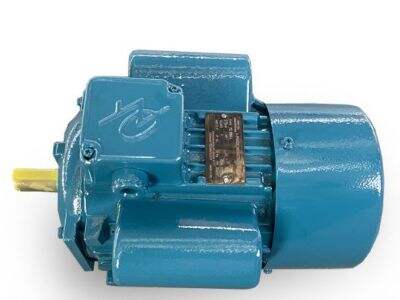Khi chúng ta nghĩ đến động cơ, chúng ta thường hình dung các máy móc chạy ở một tốc độ duy nhất. Nhưng bạn có biết về những loại động cơ đặc biệt có thể thay đổi tốc độ tùy thuộc vào công việc mà chúng đang thực hiện không? Các động cơ như vậy thường được gọi là động cơ biến tần (VFD). Vì có khả năng thích ứng với tình huống, chúng rất hữu ích và do đó hiệu quả hơn.
Cách Động Cơ VFD Thay Đổi Tốc Độ
Động cơ VFD thay đổi tốc độ bằng cách kiểm soát năng lượng điện mà nó nhận được. Thuật ngữ "tần số" có nghĩa là tốc độ mà điện năng đảo chiều hướng mỗi giây. Giờ hãy tưởng tượng một công tắc đèn mà bạn có thể bật và tắt rất nhanh. Bằng cách điều chỉnh tần số này, động cơ VFD có thể chạy nhanh hơn hoặc chậm hơn tùy theo yêu cầu. Khả năng điều chỉnh tốc độ có nghĩa là động cơ hoạt động hiệu quả hơn trong nhiều nhiệm vụ khác nhau.
Những Gì Tạo Nên Một Động Cơ VFD?
Hãy cùng xem qua các thành phần khác nhau của một động cơ VFD.
Motor: Đây là bộ phận tạo ra chuyển động. Nó chuyển đổi năng lượng điện thành năng lượng cơ học — bạn biết rồi đấy, tức là năng lượng làm quay các vật thể.
Biến tần (VFD): Đây là một thiết bị điện tử có khả năng thay đổi tần số của nguồn điện cung cấp cho motor. Nó hoạt động như một người điều khiển giao thông, quyết định lượng điện cần gửi đến motor vào bất kỳ thời điểm nào.
Bộ điều khiển: Phần này đảm bảo rằng biến tần và motor hoạt động đồng bộ với nhau. Nó phối hợp các hành động của chúng để đảm bảo mọi thứ vận hành trơn tru.
Cách motor biến tần kiểm soát tốc độ
Tiết kiệm năng lượng bằng cách kiểm soát hoạt động của biến tần VFD và động cơ: Cảm biến giúp kết hợp giữa động cơ và biến tần VFD. Những mô-đun cảm biến này là những trợ thủ nhỏ điều chỉnh dòng điện đến động cơ. Chúng theo dõi tốc độ của động cơ và giúp điều chỉnh tần số điện khi cần thiết trong quá trình vận hành. Sự điều chỉnh này ở động cơ biến tần giúp chúng luôn duy trì hiệu suất tối ưu bất kể điều kiện môi trường. Vì vậy, nếu động cơ cần tăng tốc hoặc giảm tốc, các cảm biến sẽ phát hiện và chỉ đạo biến tần thực hiện điều chỉnh.
Tại sao nên sử dụng động cơ biến tần VFD?
Những lợi ích của động cơ biến tần VFD là rất nhiều. Dưới đây là một số lợi ích chính:
Tiết kiệm năng lượng: Động cơ biến tần VFD rất tiết kiệm năng lượng vì nó chỉ tiêu thụ lượng năng lượng cần thiết để thực hiện công việc. Điều đó có nghĩa là chúng sử dụng ít năng lượng hơn, do đó hóa đơn điện cho gia đình và doanh nghiệp sẽ thấp hơn. Đây là một cách thông minh để tiết kiệm tiền!
Tính tin cậy: Động cơ VFD kém tin cậy hơn so với động cơ thông thường. Khả năng thay đổi tốc độ của chúng làm giảm khả năng hỏng hóc hoặc cần sửa chữa. Điều này khiến chúng phù hợp hơn cho nhiều máy móc và ngành công nghiệp.
Vì vậy, hoạt động yên tĩnh hơn: Một lợi ích khác đến từ thực tế là động cơ VFD hoạt động êm ái hơn so với động cơ thông thường. Điều này khiến chúng lý tưởng để sử dụng trong nhà hoặc các nơi mà tiếng ồn có thể là vấn đề. Dù sao đi nữa, không ai muốn một thiết bị ồn ào làm gián đoạn không gian yên tĩnh của họ!
Cách Động Cơ VFD Hoạt Động Cùng Nhau
Hiện tại, cách thức hoạt động của động cơ VFD có thể trông phức tạp nhưng thực tế, chúng rất thú vị. VFD tạo ra đầu ra điện, được gửi đến động cơ. Dòng điện này là điều khiến động cơ vận hành và di chuyển. Điều bạn đang làm là cung cấp một bộ điều khiển cho VFD, đồng thời đảm bảo rằng VFD và động cơ phối hợp tốt với nhau. Nó đo lường xem liệu dòng điện đúng đã được gửi đến động cơ vào đúng thời điểm hay chưa.
Biến tần thay đổi tần số của nguồn điện mà động cơ nhận được để điều chỉnh tốc độ mà nó vận hành — nhanh hoặc chậm. Sự linh hoạt này cho phép động cơ điều chỉnh cách hoạt động của mình dựa trên công việc cần thực hiện. Ví dụ, nếu động cơ phải kéo một tải nặng, nó có thể giảm tốc độ và tạo ra nhiều lực hơn. Nếu nó cần quay nhanh, nó có thể làm như vậy. Sự linh hoạt này dẫn đến hiệu suất tổng thể tốt hơn và giảm tiêu thụ năng lượng.
Kết Luận
Đối với người không chuyên, bộ biến tần VFD là những máy móc độc đáo có thể thay đổi tốc độ tùy thuộc vào công việc mà chúng phải thực hiện. Tiết kiệm năng lượng của VFD đến từ việc kiểm soát thông qua các cảm biến, bộ điều khiển và chính công nghệ VFD về cách năng lượng điện được truyền đến động cơ. Việc sử dụng động cơ VFD có những lợi thế sau: tiết kiệm năng lượng hơn, đáng tin cậy hơn và hoạt động yên tĩnh hơn. Một động cơ VFD có thể là một công nghệ tuyệt vời khi bạn hiểu cách nó hoạt động. Chúng tiết kiệm năng lượng và cải thiện hiệu suất của máy móc, làm cho cuộc sống dễ dàng hơn rất nhiều.

 EN
EN
 AR
AR
 BG
BG
 HR
HR
 CS
CS
 DA
DA
 NL
NL
 FI
FI
 FR
FR
 DE
DE
 EL
EL
 IT
IT
 JA
JA
 KO
KO
 NO
NO
 PL
PL
 PT
PT
 RO
RO
 RU
RU
 ES
ES
 SV
SV
 TL
TL
 IW
IW
 ID
ID
 SR
SR
 VI
VI
 HU
HU
 MT
MT
 TH
TH
 TR
TR
 FA
FA
 AF
AF
 MS
MS
 GA
GA
 CY
CY
 BE
BE
 MK
MK
 HY
HY
 AZ
AZ
 BS
BS

